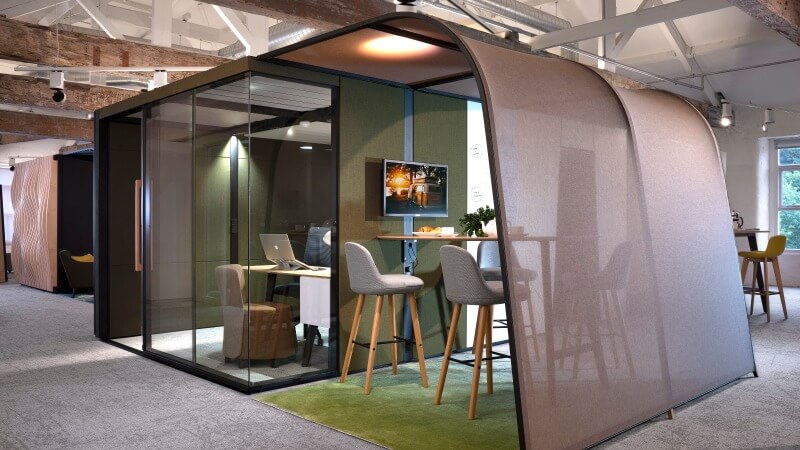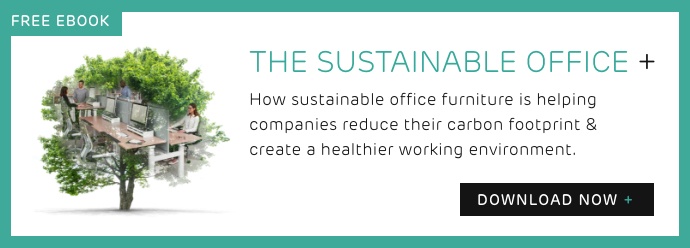The workplace has undergone more change in the last five years than it has in generations and as a result, organisations are finding themselves in uncharted waters. Employees both remote and in-office are chronically on screen, AI has radically redefined how we work, sustainability is moving steadily up the list of corporate priorities, and employee wellbeing remains a growing concern.
These four macroshifts are transforming the workplace, bringing both change and opportunity. Organisations looking to not only survive but thrive amidst this transformation need to recognise these changes and embrace them in their workspace design. Here's how.
1. Living on Screen
Virtual meetings and video calls now dominate workplace communication. Global research by Steelcase shows that 56% of meetings are remote, compared to the only 44% that are fully in-person.
Even in the office, employees choose convenience over connection, with 50% opting to stay at their desks for virtual meetings. Why? 68% find it easier to connect without needing to physically move or find it to be a more equitable experience. But 55% stay put because either dedicated meeting space is limited, or there isn’t enough time to move between meetings.
While this reliance on digital communication can offer convenience and flexibility, it also poses unique challenges for collaboration and connection. Without adequate space and privacy, employees struggle to focus, be productive, and engage during virtual meetings. In 2025, the most effective workspaces will reflect and support employees’ now digital-first reality.
How to respond to the change
Organisations that provide hybrid-ready environments that integrate easy-to-use, tech-enabled collaboration zones alongside individual video call spaces, will be better positioned to support employees’ needs.
Workplaces must also adopt designs that prioritise both privacy and accessibility. Spaces equipped with visual and acoustic privacy controls are essential for employee concentration without distractions from background noise or foot traffic.
Private, quiet rooms outfitted for video conferencing allow employees to move away from their desks to a more tailored setup for screen-based interactions, creating an environment where they can be fully present in meetings. Additionally, ample power sources and simple tech setups ensure they can connect and collaborate with minimal interruptions.
Furthermore, various meeting spaces designed specifically for hybrid collaboration have become a critical workplace asset. From enclosed collaboration rooms to open meeting zones equipped with virtual meeting technology, these spaces ensure that employees can transition smoothly between individual focus work and group meetings with remote colleagues.

2. The AI Supercycle
The rapid adoption of AI reflects a growing demand for AI skills and a fundamental shift in how work is done. 75% of knowledge workers now use AI tools daily, while 66% of leaders say they would not hire someone without AI skills.
For businesses to remain competitive and innovative, embracing AI in their workplace design as well as their strategy is now essential. That said, 60% of business leaders worry that their organisation lacks a vision to implement AI.
Looking ahead to 2025, embracing AI-ready workspaces becomes a strategic necessity to drive productivity and innovation. By embedding adaptable, tech-enabled zones and ensuring seamless integration, workplace design with AI in mind allows employees to tap into AI’s full potential while fostering a workplace culture that values continuous learning and advanced problem-solving.
How to respond to the change
When embedded in dedicated spaces, AI-powered video systems and digital assistants can enhance collaboration and streamline complex projects. Providing AI-enhanced workspaces also allows for tailored AI-driven experiences, where individuals and teams can work with virtual tools that assist with brainstorming, data processing, and task automation.
Workplace design must also account for the diverse uses of AI by creating spaces suited to different AI-driven work modes. Personal assistants and immersive displays can support focused tasks in individually owned spaces, offering personalised suggestions or real-time information processing.
For shared team settings, AI-powered video and sound systems can facilitate more dynamic collaboration, while specialised collaborative zones with large, interactive displays or shared AI hubs allow teams to leverage AI for cross-team collaboration.
These approaches make AI a natural extension of employees’ working environment rather than an isolated tool.
 Image from pg. 11 of Work Better Magazine Special Edition Fall 2024
Image from pg. 11 of Work Better Magazine Special Edition Fall 2024
3. Sustainability Mindset
A sustainability mindset is now a defining value for many organisations, driven by environmental responsibility and the demand for sustainable practices from employees and consumers. As climate concerns escalate, the number of companies committing to science-based carbon reduction targets has doubled since 2023.
This shift is more than a trend; it is a core expectation for workplaces moving into 2025 and beyond. As a result, workplace design is also evolving, with a focus on integrating sustainability into every part of the office environment. Sustainable design choices signal a commitment to global wellbeing while fostering a corporate culture that values long-term environmental impact.
The most sustainable workplaces in 2025 will integrate environmentally friendly materials and modular design as foundational elements. By planning for adaptability, sustainability becomes part of the workplace's DNA, making eco-conscious choices not only achievable but an expected standard.
How to respond to the change
To support this sustainability shift, organisations are partnering with sustainable vendors who prioritise eco-friendly materials and low-impact manufacturing processes. From recycled and reclaimed materials to products certified for low emissions, sustainable materials are a powerful way to align workplace aesthetics with environmental values.
Beyond material choices, businesses are adopting energy-efficient lighting, waste-reducing construction techniques, and furniture that can be easily repurposed or recycled. These reduce the environmental footprint of office spaces and create healthier, greener environments for employees, improving air quality and reducing exposure to harmful chemicals.
Designing fluid, adaptable workspaces is another essential component of a sustainable workplace. Spaces that can be easily reconfigured for various uses are more resource-efficient, reducing the need for costly and wasteful remodels when office space needs change.
Modular furniture, for instance, enables teams to adjust layouts based on project requirements or team size, creating a space that grows and adapts without the need for constant redesign. This minimises materials usage and supports circular design principles key to sustainable workplace design.
4. Wellbeing Urgency
The urgency around employee wellbeing has become one of the most pressing issues for organisations today. With many employees struggling to maintain a healthy work-life balance, burnout and mental health challenges have surged. A reported 66% of employees claim not to be thriving—with 69% being Millennial and Gen Z employees.
Only 59% of employees are satisfied with their work-life balance—down 12% from 2021.
The rate of change at work is accelerating faster than our ability to keep up. As a result, the demand for workplace design that prioritises holistic health is on the rise, with companies now recognising that their physical spaces play a crucial role in overall employee wellbeing.
Looking ahead, the most employee-centric workplaces in 2025 will be designed with wellbeing at their core, providing spaces that promote physical health, mental clarity, and emotional resilience.
How to respond to the change
To address this shift, modern workplace design must incorporate elements that support the full spectrum of physical, emotional, and mental health needs. Spaces designed for quiet reflection or relaxation—such as designated wellness rooms—give employees places to recharge during the day.
Access to natural light, greenery, and calming colour palettes can reduce stress levels and promote a sense of tranquillity. At the same time, secluded areas allow individuals to step away from the bustle of the office when they need quiet or focus time.

Flexible workspaces that cater to diverse working styles and needs are also essential for employee wellbeing. Offering a range of spaces—from collaborative zones to private focus rooms—empowers employees to choose the environment that best suits their tasks and personal work preferences.
Similarly, ergonomically designed furniture and areas that encourage movement also contribute to physical wellbeing, reinforcing the idea that a supportive workspace can positively impact an individual’s health, productivity, and sense of belonging. These thoughtful design choices help employees feel balanced, valued, and more in control of their work environment.
Conclusion
As we prepare for 2025, workplaces that successfully navigate these macroshifts will be those that thrive in this fast-changing world of work. Adapting to these transformative trends isn’t just about keeping up; it’s about creating spaces that drive productivity, support employee needs, and reflect core organisational values—and these are the considerations that will outlive trends and set successful workspaces apart from the rest, no matter what the future brings.











